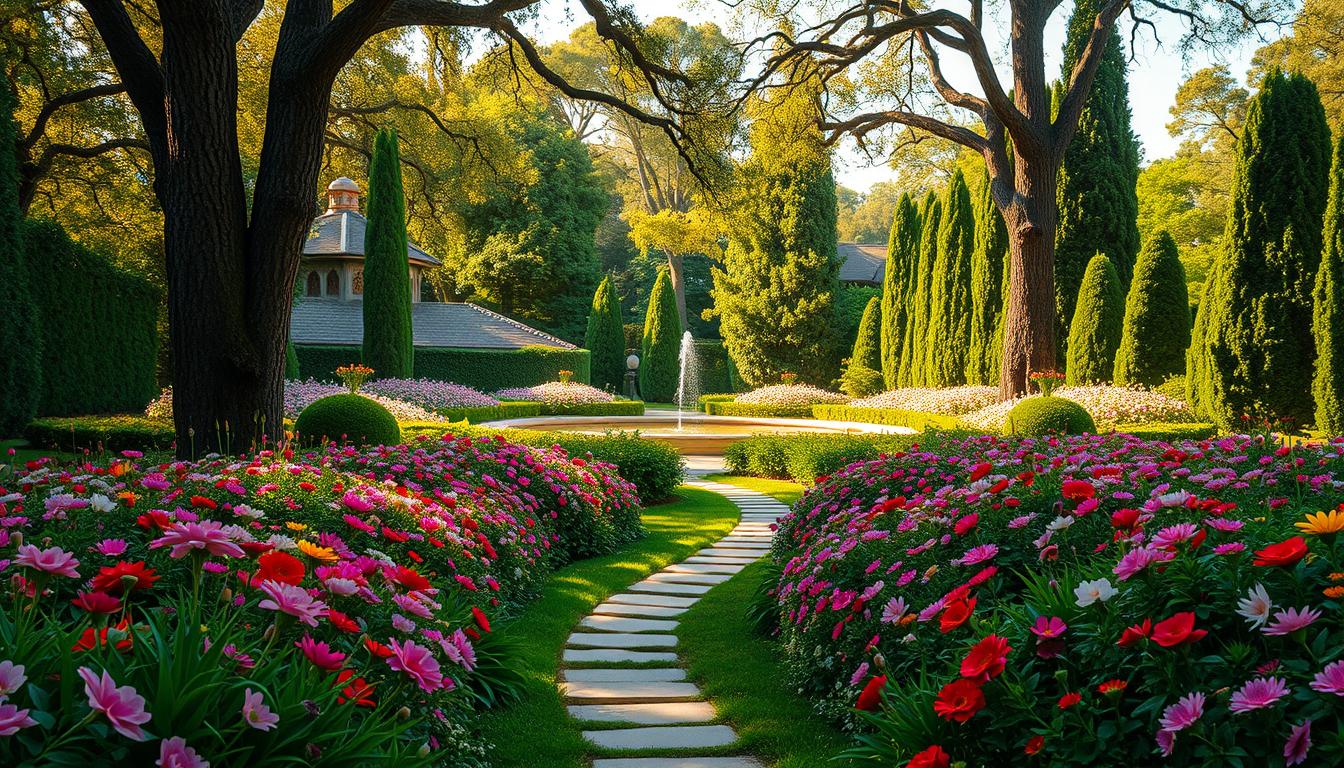Transforming your outdoor space into a personalized retreat is easier than you think. A tailored approach ensures your area meets both practical needs and aesthetic desires. Whether you’re looking to create a deer-resistant haven or a vibrant pollinator paradise, the possibilities are endless.
Seasonal adaptability is a key benefit of thoughtful planning. With the right plants and layout, your space can thrive year-round, offering visual interest in every season. From woodland paths to vertical setups, there’s a plan to suit every style and skill level.
This guide introduces 11 specialized designs to inspire your next project. Whether you’re a novice or an experienced gardener, these ideas are accessible and easy to implement. Start crafting your dream outdoor space today!
Key Takeaways
- Personalized designs transform outdoor spaces into functional and beautiful retreats.
- Tailored plans address practical needs like deer resistance and pollinator support.
- Seasonal adaptability ensures year-round visual appeal.
- 11 specialized designs cover themes like woodland paths and vertical gardening.
- Accessible for both beginners and experienced gardeners.
Introduction to the Best Garden Design Ideas
Crafting a personalized outdoor area starts with understanding your needs and vision. A well-thought-out landscape not only enhances your home’s curb appeal but also adds significant value. In fact, 78% of homeowners report increased property value with intentional design.
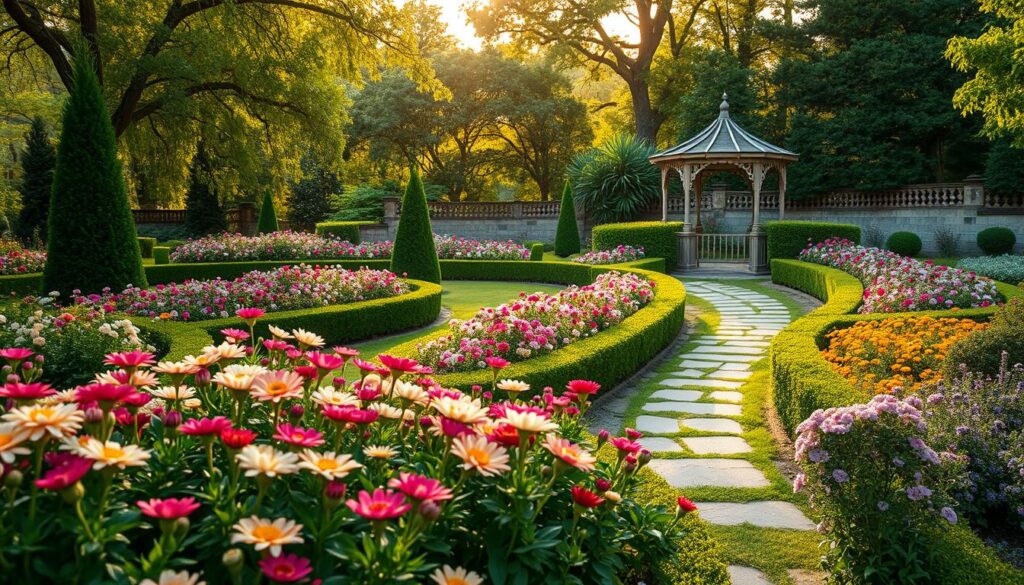
Strategic planning can also reduce maintenance time by up to 40%. By choosing native plants, you create a sustainable space that thrives with minimal effort. Sustainable landscapes use 30% less water, making them eco-friendly and cost-effective.
Why Garden Design Matters
Balancing aesthetics with functionality is key. For example, a kitchen garden combines beauty with practicality, offering fresh herbs and vegetables while enhancing your yard’s visual appeal. Jon Carloftis, a renowned horticulturist, emphasizes this blend in his work, creating spaces that are both functional and stunning.
How to Choose the Right Design for Your Space
Start by assessing your space and needs. Consider factors like sunlight, soil type, and how you plan to use the area. Professional help, such as resources from the Minnesota Nursery and Landscape Association, can guide you in making informed decisions.
Did you know? Designed habitats can increase pollinator populations by up to 60%. By incorporating pollinator-friendly plants, you not only beautify your garden but also support local ecosystems.
1. Woodland Path Garden Plan
A woodland path offers a serene escape, blending nature and tranquility seamlessly. This design mimics the forest floor, creating a peaceful retreat right in your backyard. With careful planning, you can achieve a naturalistic look that feels both inviting and effortless.
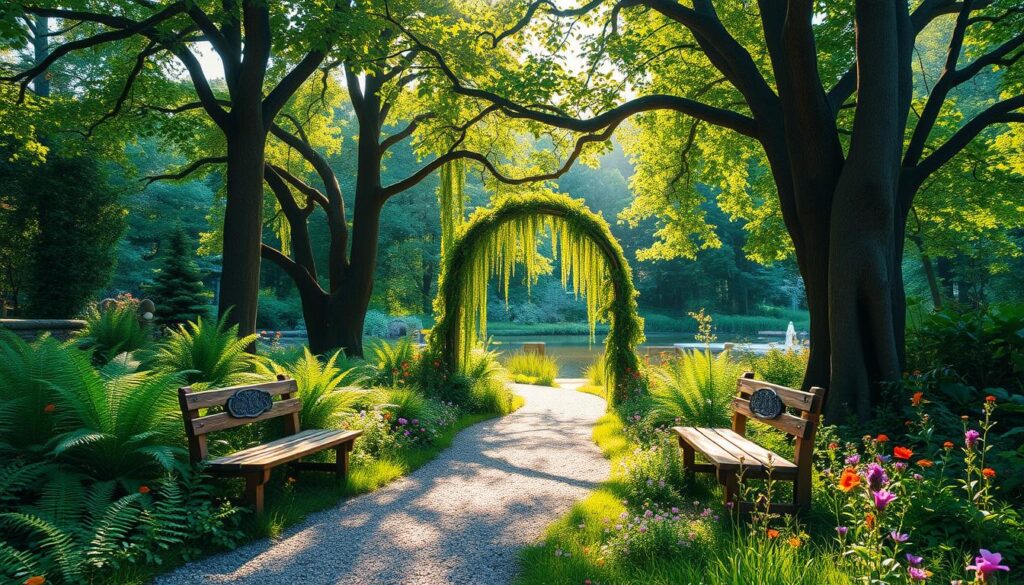
Creating a Naturalistic Path
Start by designing a curved path that follows the natural contours of your space. A width of 3-4 feet allows for easy movement while encouraging interaction with surrounding plants. Use native stone borders to maintain clean edges and add a rustic touch.
Incorporate decaying leaf mulch to mimic the forest floor ecosystem. This not only enhances the natural feel but also enriches the soil, promoting healthy growth for your shrubs and ground cover.
Plants to Include for a Woodland Feel
Choose plants that thrive in shaded, moist conditions. Ferns, trilliums, and native wild ginger are excellent choices for creating a lush, woodland atmosphere. These species add texture and depth to your garden.
For seasonal interest, include bloodroot, which blooms in early spring. Companion planting ensures continuous ground cover, keeping your space vibrant throughout the year.
With these tips, your woodland path will become a cherished part of your outdoor retreat, offering beauty and tranquility in every season.
2. Bark-Appeal Garden Plan
Unique bark textures can transform your landscape into a year-round masterpiece. By focusing on trees and shrubs with distinctive bark, you create a space that’s visually striking even in the colder months. This approach not only adds depth but also reduces maintenance by up to 60% during winter.
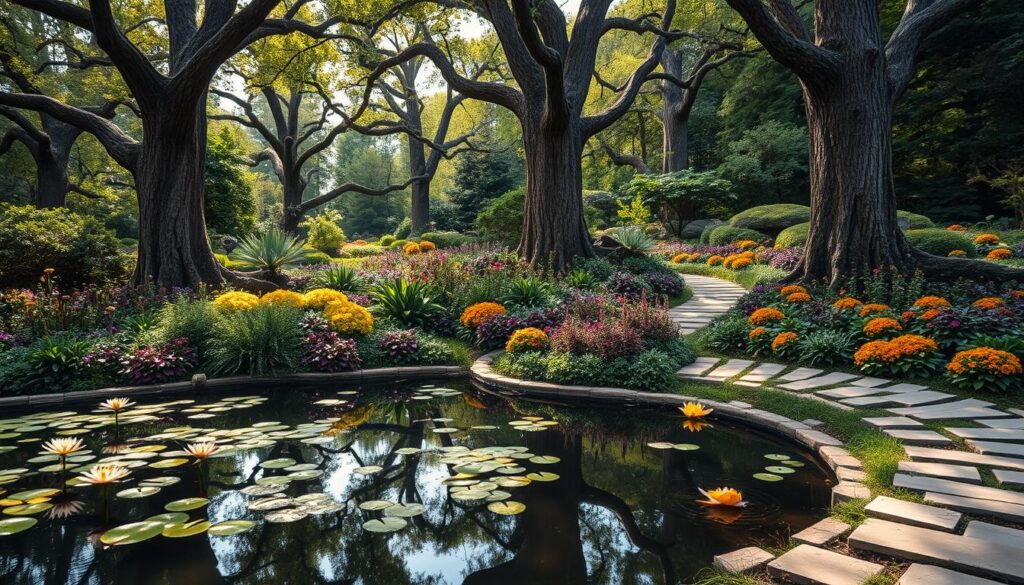
Selecting Trees and Shrubs with Unique Bark
Choosing the right species is key to achieving a bark-focused garden. Paperbark maple, river birch, and coral bark Japanese maple are excellent options. Their exfoliating bark adds texture and color, turning your space into a winter sculpture garden.
Layering textures, from the papery bark of birch to the rugged bark of oak, creates visual interest. Pair these with disease-resistant varieties for a low-maintenance appeal that thrives year after year.
Year-Round Interest in Your Garden
Evergreen groundcovers, like creeping thyme or moss, provide contrast and keep your garden vibrant even in winter. Underplanting with these species ensures continuous coverage and enhances the overall look.
Strategic lighting can highlight bark textures during shorter days. Use soft, upward-facing lights to accentuate the unique patterns of your trees and shrubs. This simple addition transforms your space into a nighttime wonderland.
With these tips, your bark-appeal garden will remain a stunning retreat throughout the year, offering beauty and functionality in every season.
3. Deer-Resistant Garden Plan
Creating a space that deters deer while maintaining beauty is both practical and rewarding. By selecting the right plants and incorporating strategic elements, you can protect your landscape from wildlife while keeping it lush and vibrant.
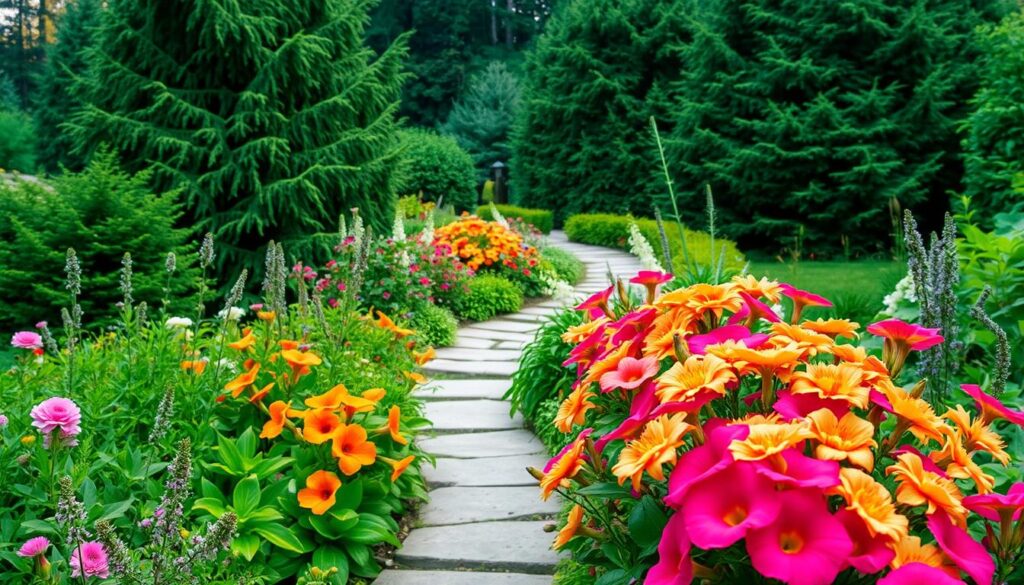
Plants That Deter Deer
Deer rely heavily on their sense of smell, which makes aromatic plants highly effective deterrents. Lavender, Russian sage, and ornamental onions are excellent choices. These plants release compounds that deer find unappealing, reducing the likelihood of them grazing in your yard.
Native plants like bee balm and yarrow also naturally repel deer while supporting local ecosystems. Incorporating these species ensures your garden remains both functional and environmentally friendly.
Designing a Garden That Wildlife Avoids
Layered planting strategies can create visual barriers that deter deer. Tall grasses like switchgrass or feather reed grass add height and texture, making it harder for deer to navigate your space. Pair these with low-growing ground covers for a cohesive look.
Motion-activated sprinklers are another effective tool. These devices startle deer with sudden bursts of water, encouraging them to stay away. Combining physical barriers like fences with aromatic plants increases success rates by up to 85%.
| Plant | Companion Plant | Benefit |
|---|---|---|
| Lavender | Rosemary | Strong aroma deters deer |
| Russian Sage | Catmint | Adds texture and scent |
| Ornamental Onions | Yarrow | Supports pollinators |
By combining these strategies, you can create a deer-resistant landscape that thrives year-round. Whether you’re protecting herbs, shrubs, or flowers, these tips ensure your yard remains both beautiful and functional.
4. Pollinator Garden
Supporting pollinators in your outdoor space is a rewarding way to boost biodiversity. These tiny creatures play a crucial role in maintaining healthy ecosystems and increasing crop yields. By creating a pollinator-friendly area, you can enjoy vibrant flowers while helping local wildlife thrive.
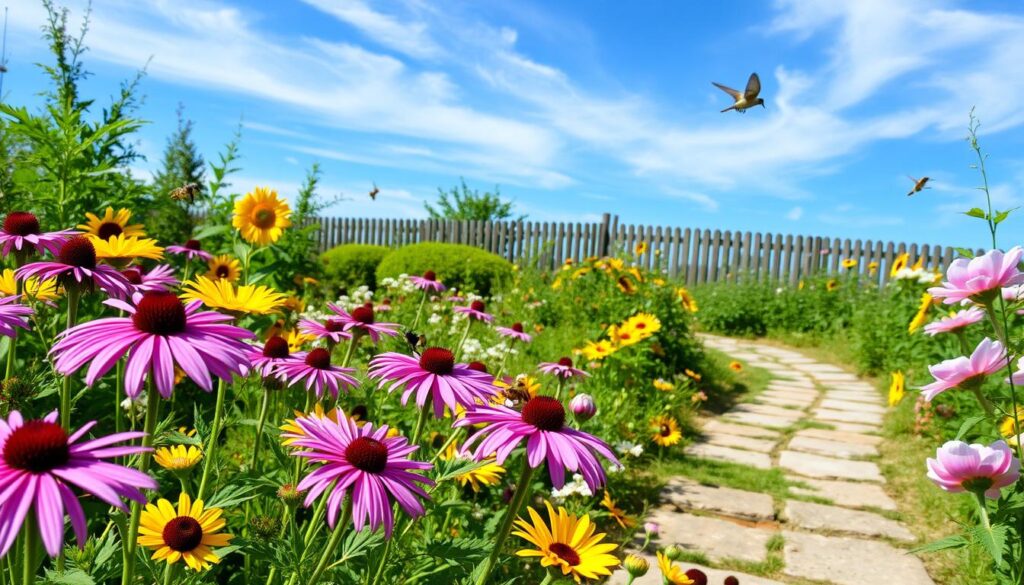
Attracting Bees, Butterflies, and Hummingbirds
Planning a bloom sequence ensures a continuous nectar source for pollinators. Early bloomers like crocus and late-season flowers such as goldenrod keep your space active throughout the year. This approach supports migratory species and ensures your area remains a hub of activity.
Adding shallow water features, like birdbaths or small ponds, creates “pollinator pit stops.” These provide essential hydration and resting spots for bees and butterflies. Place these features near clusters of plants to maximize their effectiveness.
Best Plants for Pollinators
Certain flowers are particularly effective at attracting pollinators. Milkweed, coneflower, and bee balm are top performers. These species not only provide nectar but also serve as host plants for butterflies, supporting their entire life cycle.
Color plays a significant role in attracting different species. Bees are drawn to blue and purple hues, while hummingbirds prefer red and orange. Incorporating a variety of colors ensures your space appeals to a wide range of pollinators.
| Plant | Pollinator Attracted | Bloom Season |
|---|---|---|
| Milkweed | Monarch Butterflies | Summer |
| Coneflower | Bees | Late Summer |
| Bee Balm | Hummingbirds | Mid-Summer |
Regional planting guides can help you select species that support migratory pollinators. For example, planting parsley or dill provides food for butterfly larvae. These herbs are easy to grow and add both beauty and functionality to your space.
By following these tips, you can create a pollinator-friendly area that enhances your outdoor space while supporting local ecosystems. Your efforts will not only attract bees, butterflies, and hummingbirds but also contribute to a healthier environment.
5. Ultimate Kitchen Garden Plan
A kitchen garden combines practicality with beauty, offering fresh produce right at your doorstep. Inspired by the French potager tradition, this approach mixes vegetables and ornamentals for a visually appealing and functional space. With thoughtful planning, you can reduce harvest time by up to 50% while enjoying a vibrant outdoor area.
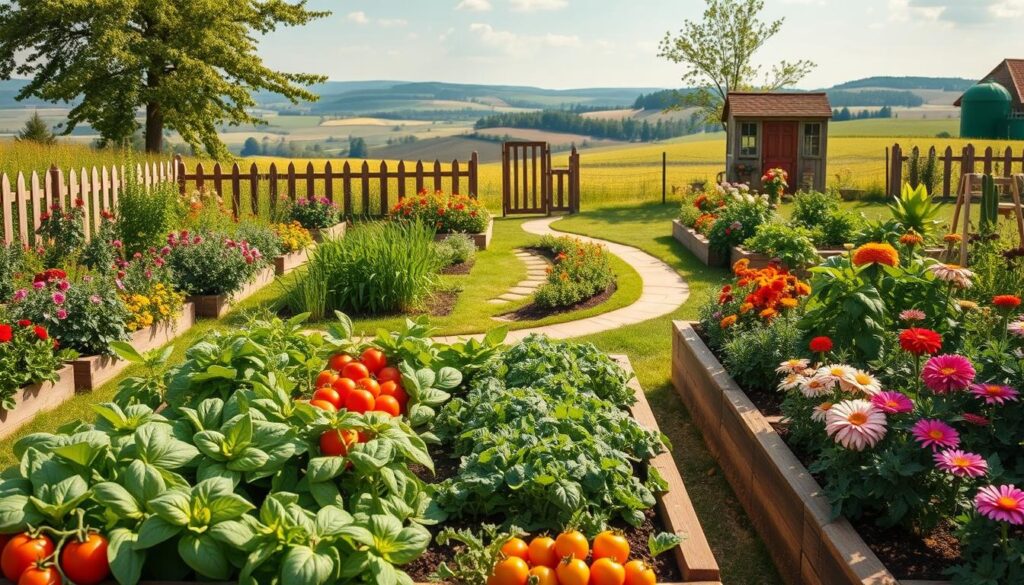
Designing a Functional and Beautiful Kitchen Garden
Start by selecting a sunny spot with well-draining soil. Raised beds are an excellent choice, providing improved drainage and warmer soil for your plants. Jon Carloftis’ signature layout incorporates edible flowers and vertical elements, adding height and interest to your space.
Successive planting ensures a continuous harvest. For example, plant quick-growing radishes alongside slower-growing tomatoes. This maximizes your space and keeps your kitchen stocked with fresh produce throughout the season.
Edible Plants to Include
Companion planting pairs like tomatoes with basil not only enhance flavor but also deter pests. Herbs like rosemary and thyme are low-maintenance and add fragrance to your garden. Incorporate decorative elements like obelisks for climbing beans, adding structure and charm.
| Plant | Companion Plant | Benefit |
|---|---|---|
| Tomatoes | Basil | Enhances flavor, deters pests |
| Carrots | Onions | Repels carrot flies |
| Beans | Marigolds | Deters nematodes |
By combining these strategies, your kitchen garden will be both productive and beautiful. Whether you’re growing herbs, vegetables, or edible flowers, this plan ensures a bountiful harvest and a stunning outdoor space.
6. Wildflower Garden
A wildflower meadow brings natural beauty and ecological benefits to your outdoor space. Native wildflowers require 75% less water than traditional lawns, making them a sustainable choice. They also provide essential habitats for pollinators and other wildlife, enhancing biodiversity in your garden.
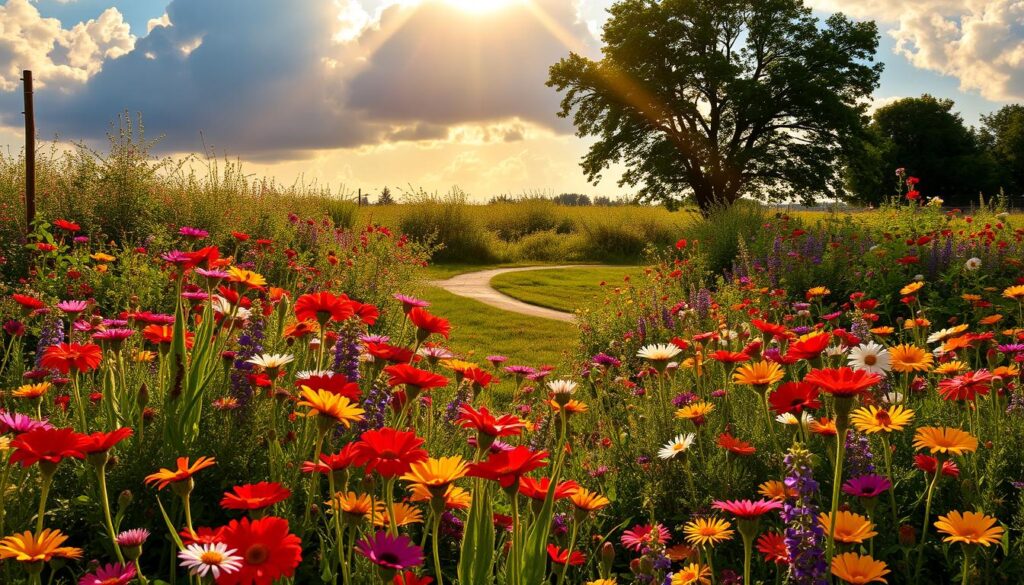
Embracing Native Wildflowers
Converting lawn areas into wildflower meadows is easier than you might think. Start by removing grass and preparing the ground for seeding. Seed stratification, a process of chilling seeds to mimic winter conditions, improves germination rates. This technique is especially useful for species like Black-eyed Susans and purple coneflower.
Choose region-specific wildflower mixes to ensure success. For example, lupines thrive in cooler climates, while blanket flowers are ideal for warmer areas. These mixes create a diverse and resilient meadow that blooms throughout the year.
Supporting Local Wildlife with Wildflowers
Wildflowers attract bees, butterflies, and birds, turning your garden into a wildlife haven. Planting in sequences ensures continuous blooms, providing food and shelter for these creatures. For instance, early bloomers like crocus support spring pollinators, while goldenrod sustains them into fall.
Maintenance is minimal but essential. Mow once a year to prevent woody plants from taking over. This controlled naturalization keeps your meadow vibrant and healthy. By creating wildlife corridors with blooming sequences, you can connect habitats and support larger ecosystems.
With these tips, your wildflower meadow will become a thriving, low-maintenance space that benefits both you and the environment. Enjoy the beauty and ecological rewards of native plants in your outdoor area.
7. Perennial Cutting Garden Plan
A perennial cutting garden offers endless blooms for stunning bouquets. This approach ensures fresh flowers throughout the year, adding beauty and purpose to your outdoor space. With thoughtful planning, you can create a vibrant area that evolves with the seasons.
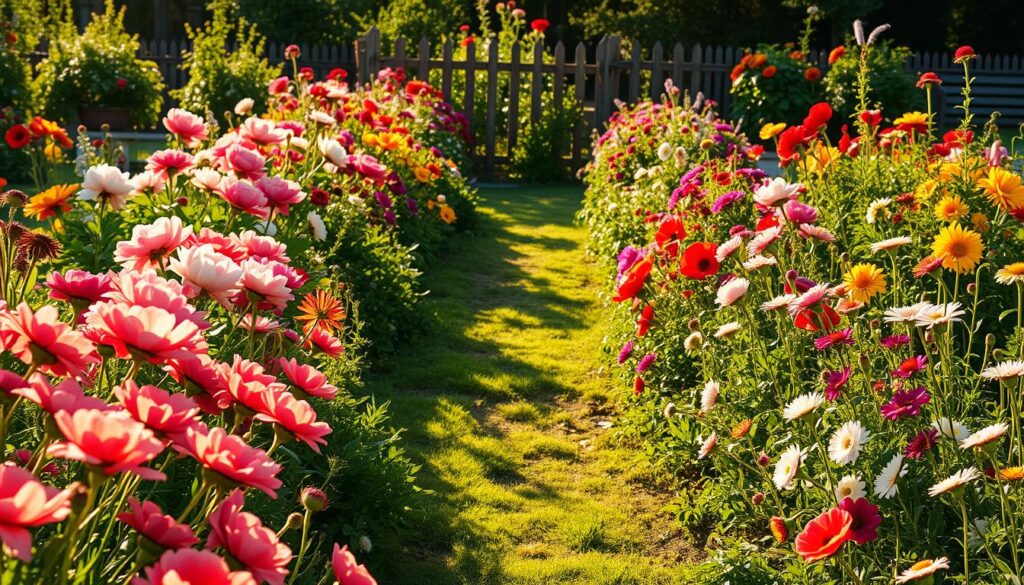
Growing Flowers for Bouquets
Successional planting is key to maintaining continuous blooms. Start with early bloomers like peonies and follow with late-season plants like dahlias. This method ensures your garden remains productive from spring to fall.
Choose varieties with strong stems and long vase life. Zinnias, snapdragons, and dahlias are excellent options. These flowers not only look stunning but also last longer in arrangements.
Designing a Cutting Garden That Evolves with the Seasons
Plan your color palette for harmonious bouquets. Combine complementary hues like purple and yellow or stick to a monochromatic scheme for a cohesive look. This adds visual appeal to your arrangements.
Incorporate foliage plants for texture. Ferns, eucalyptus, and ornamental grasses provide a lush backdrop for your blooms. These additions enhance the overall design of your bouquets.
Harvesting tips can maximize flower production. Cut stems early in the morning when they’re most hydrated. Proper techniques can extend bloom periods by up to three weeks, ensuring long-lasting beauty.
For more inspiration on creating a beautiful outdoor space, check out these boho yard decor ideas.
8. Herb Garden
Growing your own herbs brings fresh flavors and aromas right to your doorstep. Whether you have a sprawling backyard or a tiny balcony, herbs are a versatile addition to any space. They thrive in containers, raised beds, or vertical systems, making them perfect for urban dwellers and seasoned gardeners alike.
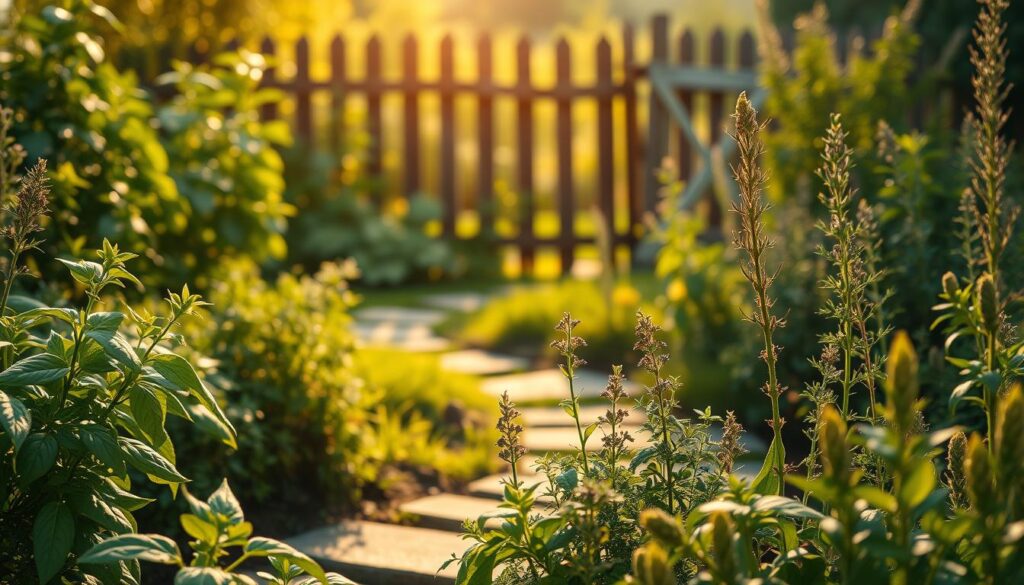
Growing Herbs in Small Spaces
Vertical herb systems are ideal for patios and balconies. Wall-mounted planters or tiered shelves maximize space while keeping your herbs accessible. Choose containers with proper drainage to prevent waterlogging, which can harm delicate root systems.
For herbs with deep roots, like rosemary, opt for deeper pots. Shallow containers work well for cilantro and parsley. This thoughtful design ensures your herbs grow healthy and strong, even in limited areas.
Annual vs. Perennial Herbs
Understanding the difference between annual and perennial herbs is key to planning your garden. Perennials like rosemary, thyme, and oregano return year after year, requiring less maintenance. Annuals, such as basil, cilantro, and parsley, need to be replanted each season.
Preserve herb gluts by drying or freezing. For example, freeze basil in olive oil for quick pasta sauces. These methods extend the life of your harvest, ensuring you enjoy fresh flavors all year round.
Companion Planting and Soil Needs
Companion planting enhances growth and deters pests. Pair basil with tomatoes to improve flavor and repel insects. Rosemary and sage are excellent companions for cabbage, as they deter harmful pests naturally.
Soil amendments vary by herb type. Mediterranean herbs like thyme and oregano prefer well-draining, sandy soil. Tropical herbs, such as lemongrass, thrive in richer, moisture-retentive mixes. Tailoring your soil ensures your herbs flourish.
| Herb | Type | Soil Preference |
|---|---|---|
| Rosemary | Perennial | Well-draining, sandy |
| Basil | Annual | Rich, moist |
| Thyme | Perennial | Well-draining, sandy |
With these tips, your herb garden will thrive, offering fresh flavors and aromas for your kitchen and beyond. Whether you’re a beginner or an experienced gardener, herbs are a rewarding addition to any space.
9. Cottage Garden
A cottage garden brings a sense of nostalgia and whimsy to any outdoor area. This informal style combines vibrant flowers, lush greenery, and charming pathways to create a space that feels both welcoming and timeless. With its “controlled chaos” philosophy, this approach allows for a relaxed yet intentional layout.
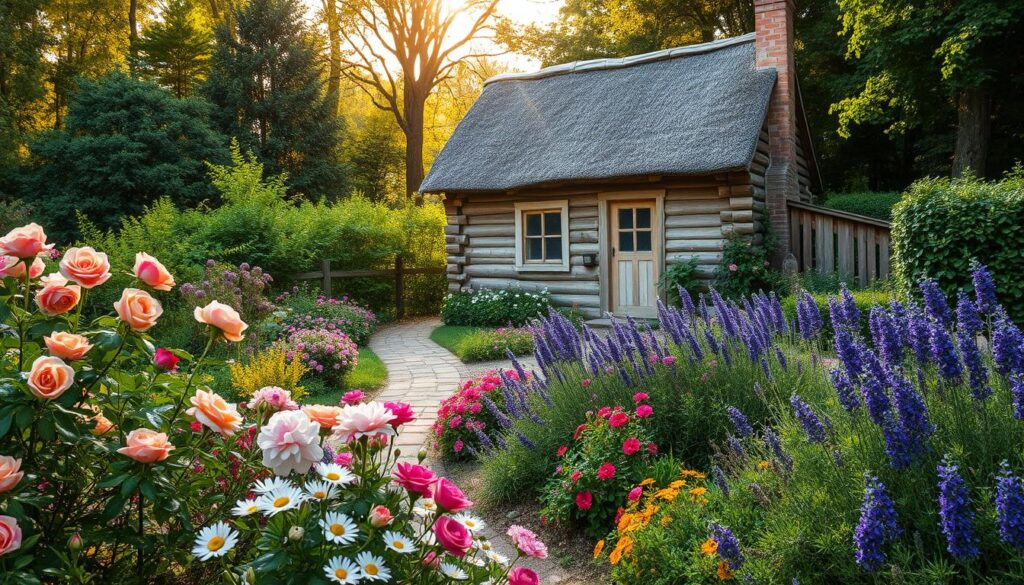
Creating a Charming and Informal Display
The key to a successful cottage garden lies in its layered design. Start with groundcovers like creeping thyme or moss to create a lush base. Add mid-height plants such as delphiniums and hollyhocks for vertical interest. Finally, incorporate climbers like roses to add height and romance.
Repurposed materials can enhance the rustic charm. Use old bricks for pathways or vintage gates as trellises. These elements not only add character but also promote sustainability by giving new life to discarded items.
Plants to Include in a Cottage Garden
Traditional choices like hollyhocks, delphiniums, and climbing roses are perfect for achieving an authentic look. Vintage varieties, such as old-fashioned roses, add a touch of history and charm. These flowers not only look beautiful but also support pollinators, making your space a haven for wildlife.
Succession planting ensures year-round interest. Pair early bloomers like peonies with late-season plants like asters. This technique keeps your garden vibrant throughout the seasons.
“A cottage garden is not just a space; it’s a feeling of warmth and connection to nature.”
- Use a mix of textures and colors for visual appeal.
- Incorporate a picket fence for a classic touch.
- Choose pollinator-friendly plants to support local ecosystems.
With these tips, your cottage garden will become a cherished retreat, blending beauty, functionality, and a touch of history.
10. Vertical Garden
Vertical gardening is a smart way to grow more in less area. Whether you have a small patio or a large backyard, this approach maximizes your space while adding greenery to walls, fences, and other structures. With the right plants and systems, you can create a lush, thriving vertical oasis.
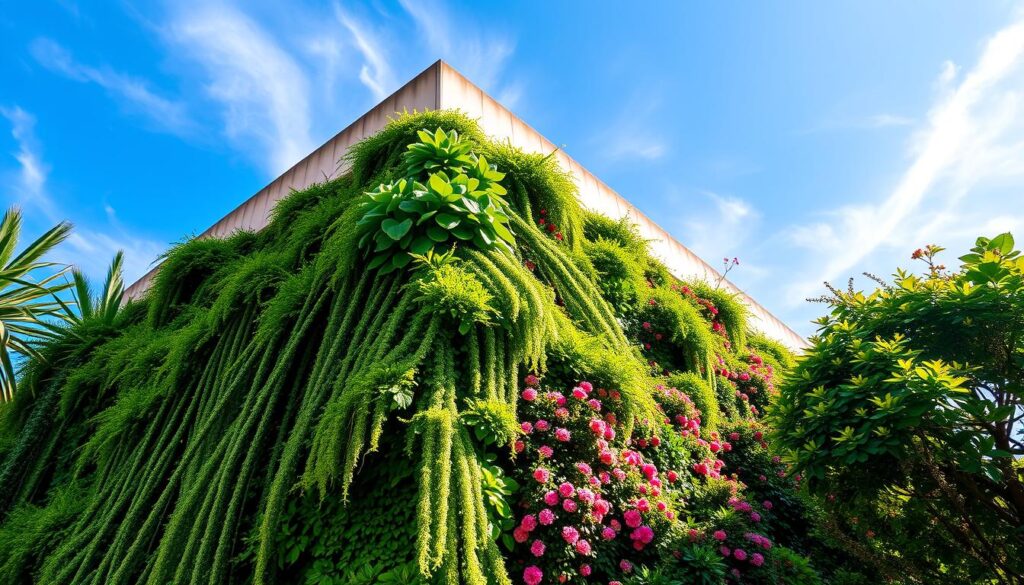
Maximizing Space with Vertical Gardening
Vertical systems like trellises, living walls, and espaliers can increase growing space by up to 400%. These structures allow you to grow upwards, making them ideal for urban environments or areas with limited ground space. Choose materials that match your design aesthetic, from rustic wood to modern metal.
Weight-bearing considerations are crucial. Ensure your structure can support the weight of the plants and soil. For example, a sturdy fence can handle climbing vines, while lightweight living walls are better for smaller plants.
Best Vining Plants for Vertical Gardens
Vining plants like clematis, morning glories, and climbing hydrangeas are perfect for vertical systems. These species naturally climb and spread, creating a lush, green wall. For edible options, consider pole beans, cucumbers, or even grapes. These not only look great but also provide fresh produce.
Irrigation is key to maintaining a healthy vertical garden. Drip systems or self-watering planters ensure even moisture distribution. Regular pruning and seasonal maintenance keep your plants thriving year after year.
| Plant | Type | Best Use |
|---|---|---|
| Clematis | Perennial | Decorative walls |
| Morning Glories | Annual | Quick coverage |
| Pole Beans | Edible | Vertical trellises |
With these tips, your vertical garden will transform any space into a green haven. Whether you’re growing flowers, herbs, or vegetables, this approach is both practical and beautiful.
11. Sustainable Landscape Design
Sustainable landscaping transforms your outdoor area into an eco-friendly haven. By focusing on principles like function, maintainability, and environmental soundness, you can create a space that benefits both nature and your lifestyle. This approach reduces maintenance while enhancing the beauty of your landscape.
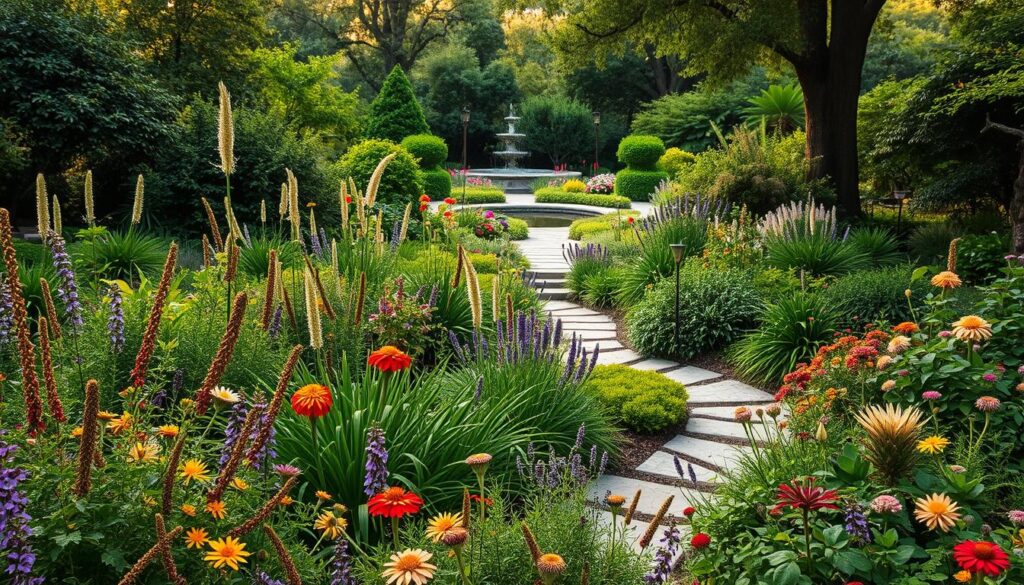
Principles of Sustainable Landscaping
Five key principles guide sustainable design: function, maintainability, environmental soundness, cost-effectiveness, and beauty. For example, proper plant selection can reduce pesticide use by up to 65%. Native plants are a great choice, as they thrive with minimal care and support local ecosystems.
Using tools like the University of Minnesota’s Site Evaluation Form helps assess your soil, sunlight, and drainage. This ensures your landscape is tailored to its environment, reducing water usage and promoting healthy growth.
Creating a Self-Perpetuating Garden
Rainwater harvesting systems are a smart addition to any sustainable design. These systems collect and store rainwater, reducing reliance on municipal water supplies. Pair this with mycorrhizal fungi inoculants to improve soil health and nutrient absorption.
Native plant communities are another essential element. Species like milkweed and coneflower support each other, creating a balanced ecosystem. This approach also attracts pollinators and other wildlife, turning your landscape into a thriving habitat.
Strategic planting can further enhance sustainability. For instance, grouping plants with similar water needs reduces waste. Adding shrubs and trees provides shade, lowering cooling costs in summer.
By following these tips, you can create a sustainable outdoor space that’s both beautiful and eco-friendly. Your efforts will benefit the environment while offering a low-maintenance retreat for years to come.
Conclusion
Your outdoor space can become a thriving, personalized retreat with thoughtful planning. By focusing on one area, like a pollinator-friendly corner or a sustainable landscape, you can create a space that benefits both your home and the environment.
Starting small allows you to experiment and grow your skills. Over time, these efforts lead to a lush, vibrant garden that thrives year after year. Sustainable practices, such as using native plants and rainwater harvesting, ensure long-term success.
For next steps, explore resources from local extension services or experts like Jon Carloftis. Their insights can guide you in creating a space that’s both beautiful and functional. Keep learning and adapting to make your outdoor area a true reflection of your vision.

